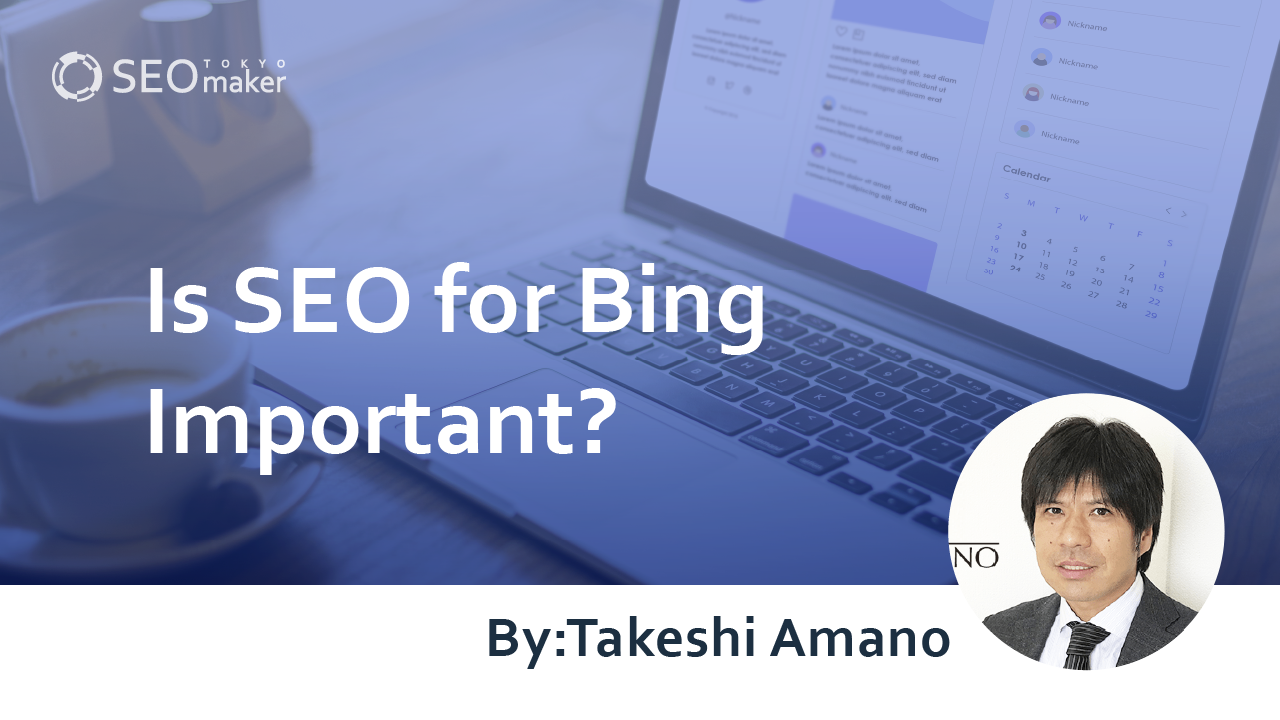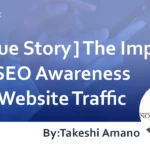Is SEO for Bing Important? : Explaining the Key Points and Tools
contents

While the term “Googling” is commonplace, many people immediately think of Google when it comes to search engines. However, Bing, despite having a significantly smaller market share compared to Google and Yahoo!, has certain aspects of SEO that cannot be ignored.
In this article, I will discuss the key points of SEO for Bing and explain some useful tools.
About Bing
Bing is a search engine launched by Microsoft in May 2009. In Japan, the market share of search engines is Google at 81.05%, Yahoo! at 13.81%, and Bing at 4.54%, showing that Bing still holds a smaller portion of the market.
Let’s look at some features of Bing.
Features of Bing
While searches on Google and Yahoo! often yield similar results, this is because Yahoo! uses Google’s search engine. However, Bing uses its own search engine and differentiates itself with a unique concept known as a ” decision engine .”
The decision engine aims to show users the sites they are likely to need at the moment, rather than simply displaying pages based on search keywords like Google and Yahoo! do.
Additionally, Bing’s design focuses on user convenience; for instance, while the desktop version of Bing displays ads at the top, bottom, and right sides of the search results, the mobile version does not show any ads.
Why SEO for Bing is Necessary
Although Bing still has a smaller share of the search engine market, why has SEO for Bing become increasingly important? There are mainly two reasons.
POINT
-Bing is the default search engine in Windows 10.
-Bing is being actively adopted in countries outside of Japan.
In Windows 10, Bing is Set as the Default Search Engine
Bing is set as the default search engine in Microsoft Edge , the browser integrated into Windows 10.
As a result, unless Windows users change their settings, they will default to using Bing for searches. Many beginners or those who find it cumbersome to change settings continue to use Bing, making it particularly effective for SEO targeting elderly users or computer novices.
Bing is Actively Adopted Abroad
Bing holds a significantly higher market share in the United States and other countries outside Japan, nearly double that within Japan.
Additionally, unlike in Japan, Yahoo! in America uses Bing’s technology for its search engine, which adds to Bing’s share when combined with Yahoo!’s own search engine market share.
Therefore, when targeting users in countries where Bing has a high market share, implementing SEO strategies that consider both Google and Bing can increase site traffic.
Key Points for SEO on Bing
SEO strategies for Bing require adherence to its search algorithm, much like those for Google. Here are three key points that are crucial when optimizing for Bing.
POINT
-Understand Bing’s algorithm.
-Consider the Webmaster Guidelines.
-Use Webmaster Tools.
Here, I will introduce three points for optimizing SEO on Bing.
Understanding Bing’s Algorithm
In SEO, it is crucial first to understand the search engine’s algorithm. Without knowing how the ranking mechanism works, it’s impossible to implement effective SEO strategies properly.
For Bing, it’s important to thoroughly comprehend its unique algorithm.
For example, while Google emphasizes keywords and text, Bing places more importance on media content like videos and audio, and it is often considered superior to Google in video searches. Additionally, whereas Google prioritizes the quality and page rank of backlinks, Bing also considers the number of backlinks and the domain age.
While there are various differences, many elements overlap with Google, so it’s wise to adapt your SEO strategies to Bing’s unique algorithms while maintaining your Google SEO efforts.
Consider the Webmaster Guidelines
Bing provides its own Webmaster Guidelines (Bing Webmaster Guidelines), similar to Google’s. These guidelines outline the factors Bing’s search algorithm prioritizes, helping you understand how to achieve higher rankings by considering these factors.
The guidelines emphasize six ranking elements focused on content (relevance, quality and trustworthiness, user engagement, freshness, location, and page loading time). These factors are largely similar to those of Google, meaning that SEO efforts effective for Google can naturally benefit Bing rankings as well.
However, there are small differences; for example, while Google does not explicitly count click-through rate (CTR) as a ranking factor, Bing considers it under user engagement. Thus, it’s important to take Bing’s Webmaster Guidelines into account.
Utilizing Webmaster Tools
Bing’s Webmaster Tools, provided for free by Microsoft, function similarly to Google’s Search Console.
These tools allow you to access data such as impressions, clicks, and average rankings, which can help you gauge your search performance. Submitting your sitemap through these tools can also help you quickly index newly published articles, potentially increasing traffic from Bing.
Unique features of Bing’s tools, not found in Google Search Console, include bi-weekly site scans that provide SEO reports pointing out areas for improvement, mobile-friendliness tests, and assessments of your pages’ mobile compatibility.
These Webmaster Tools are indispensable for SEO and should be registered and utilized when optimizing for Bing.
How to Use Bing’s Webmaster Tools
Bing’s Webmaster Tools are essential for implementing SEO strategies on Bing. Here, I will explain how to actually use them.
POINT
- Registering with Webmaster Tools
- Submit your URL
- Submit your sitemap
- Review data for site improvements
Registration Process with Webmaster Tools
First, you need to register with Bing’s Webmaster Tools, which you can do by signing in on the Bing Webmaster Tools page.
You can sign in using Microsoft, Google, or Facebook accounts.
Once registered, you will see a screen where you can either import information from Google Search Console or manually enter your site into Bing Webmaster Tools. If you are already registered with Google Search Console, you can import that data to quickly complete the registration process.
Submitting URLs
Submitting URLs functions similarly to the ‘URL Inspection’ tool in Google Search Console and can prompt the crawler to visit newly published or rewritten articles.
To submit a URL, go to ‘Submit URL’ on the left side of the screen, enter the URL you wish to submit, and send it. There are usage limits—up to 50 submissions per month and 10 submissions per day, but these limits apply per domain. So, if you manage multiple domains, each can use the tool within these limits.
Submitting URLs is a manual process, which means it needs to be done each time an article is published. While this can be time-consuming, registering tools that automatically index updated articles can save effort. Therefore, make sure to regularly submit your URLs.
Submitting Sitemaps
Submitting a sitemap to Bing can enhance crawlability and make it easier for your site to be found in search results.
To submit your sitemap, simply add the sitemap URL via the ‘Submit a Sitemap’ option on the left side of the screen. There may be a lag before it is officially registered, but once it is done, it will display as ‘Successful’.
If you do not submit a sitemap, there is a risk that essential content on your site may not be crawled or indexed, which could prevent it from appearing in Bing’s search results altogether. Therefore, ensuring your website is crawlable and easily indexed is crucial for advancing your SEO strategy on Bing.
Reviewing Data for Site Improvement
Once you have submitted your site’s URL and sitemap, it’s good to check the data available for site improvement. Bing’s Webmaster Tools provide various data that can help with this.
By registering your SNS’s URL, you can view clicks and impressions on social media, page traffic, and what keywords are driving traffic to your site. This data can be invaluable for refining your SEO strategy and aiming for higher rankings.
Furthermore, SEO reports in Bing’s Webmaster Tools can list potential SEO improvements, showing their priority, error count, and impacted pages, allowing you to check for any deficiencies in your SEO.
Although Bing’s SEO might not be considered as crucial as Google’s, it should not be overlooked, depending on your target audience. While Bing’s algorithm differs from Google’s, many principles are similar, so regular SEO practices should suffice. Using Bing’s Webmaster Tools as I’ve outlined can complement your efforts.
Providing valuable content for users is essential; if you are doing this, there is no need to focus solely on Bing’s SEO.
Bing’s Webmaster Tools offer a wealth of information for site management and SEO, making them a valuable resource for improving search rankings and increasing traffic on Bing.
Summary
In SEO strategies by Tokyo SEO Maker, focusing solely on Google often results in immediate high rankings on Bing for most keywords, frequently achieving the top position through external links alone. Bing is less strict than Google in regulating external links and evaluates content SEO with less precision, making it easier to achieve high rankings. If you are already implementing Google SEO strategies, you should encounter no issues with Bing.










![What is a Description? Explaining the Meaning, Writing Style, and Changing Word Count – [2023 Edition]](https://www.switchitmaker2.com/en/wp-content/uploads/2024/09/what-is-description.webp)










